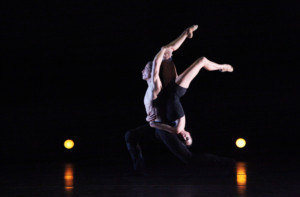Review: ICONOGRAPHIC at Sarasota Ballet

The season opening program of Sarasota Ballet presented, Iconographic; three distinctly different pieces titled Paquita, Symphony of Sorrows and Appalachian Spring.
Paquita, a story that takes place during the Napoleonic occupation of Spain, follows the life of a gypsy girl who prevents the assassination of a French officer and then discovers her own nobility. Margaret Barbieri beautifully staged this production. As the curtains part in a theatre blackout, three elaborate chandeliers hang high over the brightly lit stage to offer the breadth and depth of a spacious ballroom. With arms entwined ballerinas grace the stage in bright white and gold tutus. Principals Kate Honea and Ricardo Graziano were stunning together, radiating their strength in artistry and dexterity throughout the pieces in a whirlwind of spins and jumps that were mesmerizing. Soloists Samantha Benoit, Ryoko Sadoshim, Christine Windsor and Dagny Hanrahan were like willows in a field, gracefully nimble, bending and swaying with ease. The Corps de Ballet added to the elegance of this story and rounded off this beautiful ensemble of stellar talent highlighting classical technique.
The second piece offered was Symphony of Sorrows, a contemporary ballet choreographed by Mr. Graziano, proving he is not only an accomplished Principal dancer, but also a proficient choreographer. Brazilian born Graziano stated that this piece is a portrayal of people's reaction towards death and the loss of a loved one. Despite the grim sounding theme, this was my favorite of the three productions and by far one of the most moving pieces of ballet I have encountered. It was brilliantly staged with male and female dancers in black, a stark stage of black, a few orange light bulbs hung from the ceiling, and a few afoot on the stage. The ominous and almost monotonous organ music that haunted this piece was foreboding yet comforting in an odd way. With their backs to the audience, the bare chested male dancers slowly walked in a tight knit collective away from the audience. In the distance was a darkness that enveloped them out of sight. As the men disappeared, the women move to leave the group, covering their eyes, perhaps not wanting to see death or not accepting the loss of a loved one. When the male and female dancers pair off in couples, the men carry their partners on their backs in various burdening positions, wiling to do what it takes to escort them, one last time. As one pair retreats to the abyss at the back of the stage, another pair emerges, and another, and another. You may interpret the men as kind angels of death carefully chaperoning the women to their final rest or perhaps they are departed loved ones briefly piercing the other side to offer comfort through a journey in which they are familiar. When the final compression of bodies move to the abyss, one woman briefly looks back toward the audience, as if to reflect on her life and to say her final goodbye. She then slowly joins the rest of the ensemble who disappear into the darkness. However you perceive it, this was a vision of solitude, dignity and compassion so well executed in the form of ballet. I feel this also exemplified the rigorous training and physical strength it takes to embody this type of performance. Stunning. Haunting. Brilliant.
Martha Graham choreographed the third piece titled Appalachian Spring, with music by Aaron Copeland. Copeland, known for his ballet scores for Billy the Kid and Rodeo, was a grand choice giving this piece the cowboy feel in which it was intended. The ballet follows the story of a young pioneer couple (Kate Honea and Ricardo Graziano) who reflect on their lives before getting married and setting up house in the wilderness. Accompanying the couple is a revivalist (Jamie Carter) who delivers a sermon, a wise pioneer woman (Lauren Ostrander) who oversees the events and four female followers of the revivalist. The stage is scantly dressed with the frame of a house, a small thin rocking chair on the porch, and a fence the couple can lean on to oversee their property. A little harder to understand or follow exactly what was happening, the program notes explain it further. Quoted from the Los Angeles times in a summary of the ballet, "Graham shows a couple that will face a future that will not be all sweetness and light but she also draws out the private and shared emotional resources they will be able to bring to such challenges." This piece is full of continuous swirls and broad jumps. At one point Mr. Graziano reminded me of Seven Brides for Seven Brothers with his cowboy knee slaps and high jumps. The Americana score underlies the rise and fall of hope and fear that the couple face starting their new lives together.
Under the direction of Iain Webb, Sarasota Ballet never fails to impress. They choose visually stunning pieces and are fearless in producing difficult works that challenges their immensely talented ensemble who are always up to the task.
For more information on Sarasota Ballet and their upcoming season of productions visit www.sarasotaballet.org.
Reader Reviews

Videos
